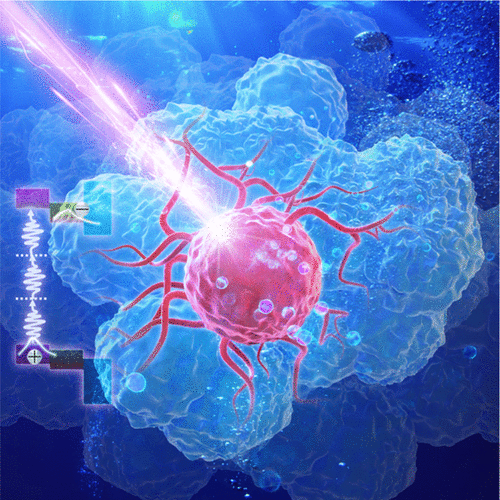当前位置:
X-MOL 学术
›
J. Phys. Chem. C
›
论文详情
Our official English website, www.x-mol.net, welcomes your feedback! (Note: you will need to create a separate account there.)
Photophysical Properties of Water-Soluble CdTe/CdSe/ZnS Core/Shell/Shell Nanocrystals Emitting at 820 nm
The Journal of Physical Chemistry C ( IF 3.7 ) Pub Date : 2020-03-24 , DOI: 10.1021/acs.jpcc.0c01027 Yang Gao 1 , Huan Liu 1 , Junzi Li 1 , Xiangquan Deng 2 , Wenbo Hu 3 , Shuyu Xiao 1 , Xin Qiu 1 , Xiaodong Lin 1 , Ke Wang 2 , Tingchao He 1
The Journal of Physical Chemistry C ( IF 3.7 ) Pub Date : 2020-03-24 , DOI: 10.1021/acs.jpcc.0c01027 Yang Gao 1 , Huan Liu 1 , Junzi Li 1 , Xiangquan Deng 2 , Wenbo Hu 3 , Shuyu Xiao 1 , Xin Qiu 1 , Xiaodong Lin 1 , Ke Wang 2 , Tingchao He 1
Affiliation

|
The photophysical properties of near-infrared-I (NIR-I)-emissive type-II semiconductor nanocrystals (NCs), such as their excitonic properties and multiphoton absorption (MPA), have been rarely reported. In this work, the photophysical properties of water-soluble CdTe/CdSe/ZnS core/shell/shell NCs emitting at 820 nm were investigated using various spectral tools. Through the measurements of temperature-dependent photoluminescence (PL) spectra, the coefficient of the band gap change of CdTe/CdSe/ZnS core/shell/shell NCs was determined as −1.01 × 10–5 K–1, while the coupling strength of exciton–acoustic phonon and exciton longitudinal optical (LO) phonon and the LO phonon energy were determined to be 120 μeV/K and 26 and 77 meV, respectively. Their linear absorption cross section was determined as 1.09 × 10–15 cm2 at 500 nm, using femtosecond transient absorption spectroscopy. More importantly, the MPA cross sections of CdTe/CdSe/ZnS NCs excited in the NIR-II (1000–1340 nm) and III regions (1620–1840 nm) were measured, with the maximum two- and three-photon absorption cross sections of NCs being 3.80 ± 0.19 × 106 GM at 1000 nm and 1.28 ± 0.06 × 10–76 cm6 s2 photon–2 at 1700 nm, respectively. In addition, their biocompatibility and NIR-III-excited in vitro bio-imaging have been demonstrated. The good water dispersibility, high exciton stability, and strong multiphoton-excited PL brightness ensure that these NIR-I-emitting CdTe/CdSe/ZnS NCs will be very promising in the applications of various optoelectronic devices and deep-tissue biological imaging.
中文翻译:

水溶性CdTe / CdSe / ZnS核/壳/壳纳米晶体在820 nm发射的光物理性质
几乎没有报道过近红外I(NIR-I)发射II型半导体纳米晶体(NCs)的光物理性质,例如其激子性质和多光子吸收(MPA)。在这项工作中,使用各种光谱工具研究了在820 nm处发射的水溶性CdTe / CdSe / ZnS核/壳/壳NC的光物理性质。通过测量随温度变化的光致发光(PL)光谱,CdTe / CdSe / ZnS核/壳/壳NC的带隙变化系数确定为−1.01×10 –5 K –1,而激子-声子和激子纵向光学(LO)声子的耦合强度和LO声子的能量分别确定为120μeV/ K和26和77 meV。使用飞秒瞬态吸收光谱法测定了它们在500 nm处的线性吸收截面为1.09×10 –15 cm 2。更重要的是,测量了在NIR-II(1000-1340 nm)和III区域(1620-1840 nm)中激发的CdTe / CdSe / ZnS NCs的MPA截面,最大的两个和三个光子吸收截面的NCs在1000 nm处为3.80±0.19×10 6 GM和1.28±0.06×10 –76 cm 6 s 2光子–2分别在1700 nm 另外,已经证明了它们的生物相容性和NIR-III激发的体外生物成像。良好的水分散性,高激子稳定性和强的多光子激发PL亮度确保这些发射NIR-I的CdTe / CdSe / ZnS NCs在各种光电器件和深层组织生物成像的应用中将非常有前途。
更新日期:2020-03-26
中文翻译:

水溶性CdTe / CdSe / ZnS核/壳/壳纳米晶体在820 nm发射的光物理性质
几乎没有报道过近红外I(NIR-I)发射II型半导体纳米晶体(NCs)的光物理性质,例如其激子性质和多光子吸收(MPA)。在这项工作中,使用各种光谱工具研究了在820 nm处发射的水溶性CdTe / CdSe / ZnS核/壳/壳NC的光物理性质。通过测量随温度变化的光致发光(PL)光谱,CdTe / CdSe / ZnS核/壳/壳NC的带隙变化系数确定为−1.01×10 –5 K –1,而激子-声子和激子纵向光学(LO)声子的耦合强度和LO声子的能量分别确定为120μeV/ K和26和77 meV。使用飞秒瞬态吸收光谱法测定了它们在500 nm处的线性吸收截面为1.09×10 –15 cm 2。更重要的是,测量了在NIR-II(1000-1340 nm)和III区域(1620-1840 nm)中激发的CdTe / CdSe / ZnS NCs的MPA截面,最大的两个和三个光子吸收截面的NCs在1000 nm处为3.80±0.19×10 6 GM和1.28±0.06×10 –76 cm 6 s 2光子–2分别在1700 nm 另外,已经证明了它们的生物相容性和NIR-III激发的体外生物成像。良好的水分散性,高激子稳定性和强的多光子激发PL亮度确保这些发射NIR-I的CdTe / CdSe / ZnS NCs在各种光电器件和深层组织生物成像的应用中将非常有前途。



























 京公网安备 11010802027423号
京公网安备 11010802027423号